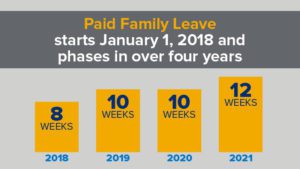Effective Date for New York’s Paid Family Leave Right Around the Corner
By Keith Gutstein and Erika Rosenblum
The New York State Paid Family Leave law goes into effect on January 1, 2018. Therefore, it is imperative that employers take the necessary steps to prepare for this significant change.
The New York Paid Family Leave Law (PFL) requires employers to provide paid leave for eligible who employees who need time off for certain qualifying conditions, such as (1) maternity and paternity Leave; (2) caring for a close relative with a serious health condition; and (3) active duty deployment. Unlike the federal Family and Medical Leave Act (FMLA), the PFL does not provide leave to employees for their own health conditions.
The PFL applies to all private employers covered by the New York State Workers’ Compensation Law, regardless of the size of the employer. This differs from the FMLA which only applies to larger employers (those with 50 or more employees). Though essentially all New York employers are covered by the PFL, not every employee will be eligible for paid leave. Rather, employees with a regular work schedule of 20 or more hours per week are eligible after 26 weeks of employment. For employees with a regular work schedule of less than 20 hours per week, they shall be eligible after 175 days of employment. Employees who do not expect to work long enough to qualify for PFL may opt out of coverage so that they are not subjected to payroll deductions, but must complete a “waiver of benefits” form.
PFL benefits are provided by insurance that employees fund via an employee payroll deduction. Though some employers began the payroll deductions as of July 1, 2017, others may have decided to wait to commence such deductions until January 1, 2018. A maximum rate of employees’ contribution will be established each year by the Superintendent of the Department of Financial Services. For coverage beginning January 1, 2018, the maximum employee contribution shall be 0.126% of an employee’s weekly wage, up to and not to exceed the statewide average weekly wage.
In the first year of the PFL, eligible employees will receive 50% of their average weekly wage, up to 50% of the statewide average weekly wage, for a maximum of eight (8) weeks of leave. In 2021, when the PFL is fully phased in, the maximum  benefit will be 67% of the employee’s average weekly wage, up to 67% of the statewide average weekly wage for up to twelve (12) weeks of leave.
benefit will be 67% of the employee’s average weekly wage, up to 67% of the statewide average weekly wage for up to twelve (12) weeks of leave.
Under the PFL, while an employee is on leave, employers must continue the employee’s health insurance. In the event that the employee contributes to the cost of their health insurance, the employee must continue to pay their portion of the premium cost while on paid family leave. The PFL also requires that employees be permitted to return to their job once they have completed their paid family leave.
When an employee wishes to use paid leave, the employee should provide their employers with at least 30 days’ notice of their intention to use PFL. However, in the event that the employee’s need for leave is not foreseeable, the employee must notify their employer as soon as practicable. Employees should submit the required forms and information to their employer’s PFL insurance carrier within 30 days of the start of paid leave. Employers should therefore have these forms for their employees, or be able to direct them to the PFL insurance carrier or website where they can be found. Insurance carriers are required to process the claim and issue a determination within 18 days of receiving the claim package. Once an employee’s request for leave under New York’s PFL is granted, employers must provide the actual dates employees are out of work for PFL purposes. Notably, unlike the FMLA, while employers can give employees the choice to use accrued paid time off (PTO) during paid leave under the PFL, employers cannot mandate that the employee use any PTO while out on leave under the PFL.
Steps Employer Should Take Now
As the PFL requires that employers use certain forms and implement specific procedures and protocols, employers should use the remaining time left in 2017 to make sure their HR policies are ready for the PFL. This includes updating their employee handbooks to include a PFL policy, securing the necessary insurance coverage for payment of the PFL benefits, obtaining the posters as required by the PFL, and preparing to handle employee requests for paid leave.










